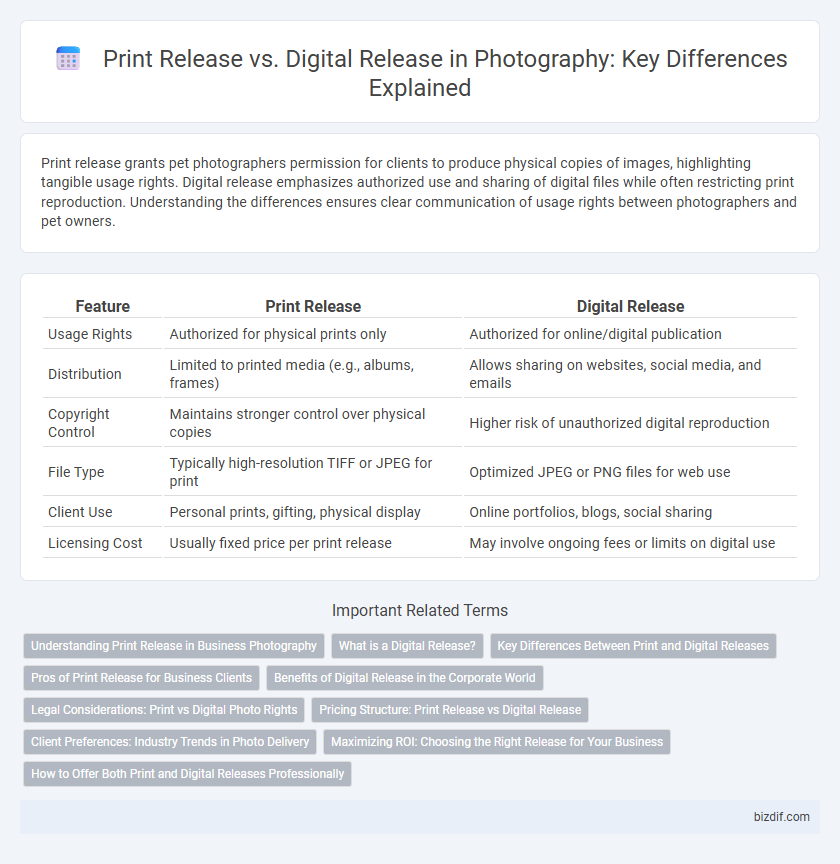Print release grants pet photographers permission for clients to produce physical copies of images, highlighting tangible usage rights. Digital release emphasizes authorized use and sharing of digital files while often restricting print reproduction. Understanding the differences ensures clear communication of usage rights between photographers and pet owners.
Table of Comparison
| Feature | Print Release | Digital Release |
|---|---|---|
| Usage Rights | Authorized for physical prints only | Authorized for online/digital publication |
| Distribution | Limited to printed media (e.g., albums, frames) | Allows sharing on websites, social media, and emails |
| Copyright Control | Maintains stronger control over physical copies | Higher risk of unauthorized digital reproduction |
| File Type | Typically high-resolution TIFF or JPEG for print | Optimized JPEG or PNG files for web use |
| Client Use | Personal prints, gifting, physical display | Online portfolios, blogs, social sharing |
| Licensing Cost | Usually fixed price per print release | May involve ongoing fees or limits on digital use |
Understanding Print Release in Business Photography
A print release in business photography grants clients the legal permission to produce physical copies of images, specifying usage rights and limitations for print materials such as brochures, posters, and marketing collateral. Unlike digital releases, which often cover online sharing and digital distribution, print releases emphasize tangible media rights, ensuring photographers retain control over reproduction quality and quantity. Properly structured print releases protect photographers from unauthorized printing while providing businesses with clear guidelines for legitimate use of images in their physical advertising campaigns.
What is a Digital Release?
A Digital Release in photography refers to the permission granted by a photographer allowing the client to use digital copies of images without restrictions for personal or commercial purposes. Unlike a Print Release, which specifically authorizes the printing of photos, a Digital Release encompasses the use, sharing, and reproduction of images across various digital platforms. This type of release ensures clear rights management and helps prevent unauthorized distribution or misuse of digital photos.
Key Differences Between Print and Digital Releases
Print releases grant explicit permission to reproduce and distribute physical copies of photographs, often with strict limitations on size and quantity, while digital releases authorize the use and sharing of images in online platforms and electronic formats, typically with broader access and fewer physical constraints. Print releases usually require higher resolution files tailored for high-quality printing, whereas digital releases prioritize optimized image sizes and formats suitable for web display and social media sharing. Licensing terms differ as print releases may involve royalties or fees tied to printed copies, whereas digital releases focus on usage rights across digital channels, including websites, email marketing, and digital advertisements.
Pros of Print Release for Business Clients
Print release grants business clients the legal right to reproduce and distribute physical copies of images, enhancing brand visibility through tangible marketing materials like brochures, posters, and product packaging. This type of permit ensures control over image quality and consistency across all printed collateral, reinforcing professional branding standards. Clients benefit from expanded usage options and a clear, customizable licensing agreement that supports diverse promotional strategies in traditional marketing channels.
Benefits of Digital Release in the Corporate World
Digital release in photography streamlines corporate workflows by enabling instant, high-quality image distribution across global offices and marketing channels, reducing delays and printing costs. It supports versatile usage rights management, allowing corporations to control image licensing easily while maintaining brand consistency. Enhanced accessibility and security features in digital release platforms ensure authorized personnel can access and share assets efficiently, boosting collaboration and marketing agility.
Legal Considerations: Print vs Digital Photo Rights
Print releases grant clients explicit permission to produce physical copies of photographs, often restricting unauthorized commercial use, while digital releases typically cover online sharing and digital distribution rights. Legal considerations emphasize the specific usage terms outlined in each release type, with print releases requiring clear limitations on reproduction quantity and format to protect the photographer's copyright. Understanding distinctions between print and digital photo rights is essential to prevent infringement and to maintain control over intellectual property in various media.
Pricing Structure: Print Release vs Digital Release
Print releases typically involve a one-time fee granting clients permission to produce physical copies of photographs, often priced based on print size and quantity. Digital releases usually offer more flexible pricing models, sometimes including flat rates or subscription plans for unlimited digital use, reflecting the ease of distributing electronic files. Pricing structures for print releases tend to be higher due to production costs, whereas digital releases prioritize accessibility and broader usage rights.
Client Preferences: Industry Trends in Photo Delivery
Client preferences in photo delivery increasingly favor digital releases due to faster access and ease of sharing across social media platforms. Print releases remain valued for high-quality physical products, appealing to clients seeking tangible keepsakes or professional portfolios. Industry trends suggest a hybrid approach, combining digital convenience with print's lasting impact, caters best to diverse client needs.
Maximizing ROI: Choosing the Right Release for Your Business
Maximizing ROI in photography hinges on selecting the appropriate release type; print releases grant clients rights to produce physical copies, often commanding higher fees and extended usage privileges. Digital releases focus on online distribution, offering scalable licensing that supports diverse digital platforms and broad audience reach. Understanding client needs and usage scope enables photographers to tailor releases, optimizing revenue streams and protecting intellectual property effectively.
How to Offer Both Print and Digital Releases Professionally
Offering both print and digital releases professionally requires clear licensing terms that specify usage rights for each format, ensuring clients understand their permissions for prints and digital sharing. Providing high-resolution files for print alongside optimized versions for digital use maintains quality standards while protecting the photographer's copyright. Implementing streamlined contracts and delivery methods enhances transparency and client satisfaction, reinforcing professional trust.
Print release vs Digital release Infographic

 bizdif.com
bizdif.com